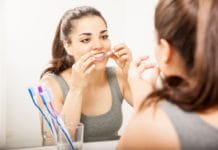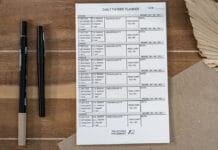Everyone has a daily routine. Some people brush their teeth and then grab a cup of coffee on the way to work. Certain routines affect oral health. Here are some simple things that many people, including dental hygienists, may forget are not the best for them to do.
1) Sipping all day!
Sipping on sugary and acidic coffees, teas, energy drinks, or soda all day affects the oral cavity’s pH. When consuming sugary or acidic drinks, the mouth’s pH lowers to an acidic state, creating the prime environment for bacteria to thrive and can lead to dental caries (cavities). So, when someone is sipping on the same drink all day, the oral cavity’s pH is like a rollercoaster going from a neutral state (which is considered a seven on the pH scale) to a very acidic one.
To discover patients’ habits, a caries risk assessment (CAMBRA) and dietary counseling analysis can be performed. Some key questions to ask are what they are drinking or consuming and how frequently they consume that food/beverage. You may also want to ask what they add to their coffee or tea. Are they adding packets of sugar or flavored syrups as well?
In addition, using straws can be helpful. When you use straws, fewer teeth will be exposed to the beverage. This can also avoid generalized staining (making staining more localized).
2) Don’t brush your teeth after drinking coffee.
Speaking of coffee, brushing your teeth right after coffee is something to avoid. Coffee stain would be considered an extrinsic stain. Many patients notice their staining and want solutions. After drinking a cup of coffee, some want to brush their teeth to remove the staining or the coffee breath. In the patient chair, coffee stain can be scaled and polished off.
Patients should wait to brush their teeth after consuming stain-causing and acidic drinks such as coffee, teas, and juice (and eating too). After drinking these types of beverages, brushing immediately afterward would be brushing the acidity around the mouth and on the teeth surfaces. This could lead to caries or damage to the tooth structure (erosion and abrasion). It is best to postpone brushing for at least 20-30 minutes. In the meantime, rinsing with water can be an option.
3) Lemons … and other acidic foods.
As we know, lemons are very acidic. When someone sucks on lemons directly, teeth erosion can be likely to occur, which is the loss of the enamel (tooth surfaces). Erosion may also cause teeth sensitivity. (If sensitivity occurs, a recommendation of sensitivity home care supplies such as toothpastes or rinses, as well as a fluoride treatment, maybe suggested).
To improve outcomes, dilute the acidity of the lemons, in this case. This may mean drinking water when consuming acidic fruits such as lemons and oranges. Additional nutritional counseling/dietary analysis can also be helpful during oral hygiene instruction.
4) Biting nails.
A common habit that patients do is bite their nails. They may do it out of boredom or as a coping mechanism when they are anxious or stressed. Biting or chewing on nails allows the opportunity for bacteria to enter the mouth and the whole body.
In addition, the habit can result in teeth shifting, damage, or chipped teeth.1 According to the American Dental Association, biting/chewing nails can affect the jaw as well. The ADA reports, “Placing your jaw for long periods of time in a protruding position can place pressure on it, which is associated with jaw dysfunction.”2 (Similar damages can occur when chewing harder items such as ice cubes.)
5) Improper homecare habits.
Brushing, interdental cleaning (flossing), rinsing, and repeat. Simple right? Even with an oral hygiene instruction demonstration chairside, patients have their own routine and oral hygiene habits. They may forget a step or misunderstand the instruction. Common home care errors are brushing aggressively, unequal brushing around the mouth, and incorrect interdental cleaning methods.
Scrubbing and brushing too hard can have drastic effects on a patient’s tooth structure, such as toothbrush abrasion and recession (though parafunctional habits and occlusion play a huge role in recession and abrafractions). Abrasion and recession then could result in sensitivity.
Unequal brushing can also cause damage to the oral cavity. This involves missing areas of the mouth, allowing bacteria to remain longer on the teeth. This can lead to multiple concerns such as inflammation, decalcification, periodontal disease, and caries. Using a timer, playing a song (at least two minutes long), or using an electric toothbrush with a built-in timer can resolve this issue.
Lastly, incorrectly using floss can cause trauma to the gingiva, such as floss cuts. The best way to avoid floss cuts is to make sure the floss is forming (hugging) to each side of the tooth in the class C-shape method. Avoiding snapping the floss is another to reduce the chance of gingival injury. Skipping string floss altogether and using interdental cleaners such as interdental brushes, water flossers, or a combo of both may be even easier and more effective for a patient.
Habits can be difficult to break. There may be setbacks or relapses, but that is a normal occurrence. Being aware of the habit is a great start to change and stop the behavior. Dental professionals have the opportunity to guide patients in the right direction with our recommendations and knowledge. We are also someone who can listen to them when they need support in making habitual behavior changes.
Before you leave, check out the Today’s RDH self-study CE courses. All courses are peer-reviewed and non-sponsored to focus solely on high-quality education. Click here now.
Listen to the Today’s RDH Dental Hygiene Podcast Below:
References
- Hernandez, D. (2016, December 9). 5 Reasons to Stop Biting Your Nails. Vital Record News from Texas A&M Health. Retrieved from https://vitalrecord.tamhsc.edu/biting-nails/
- American Dental Association. (n.d.). 6 Habits that Harm your Teeth (and How to Break Them). Mouth Healthy. Retrieved from https://www.mouthhealthy.org/en/bad-habits












